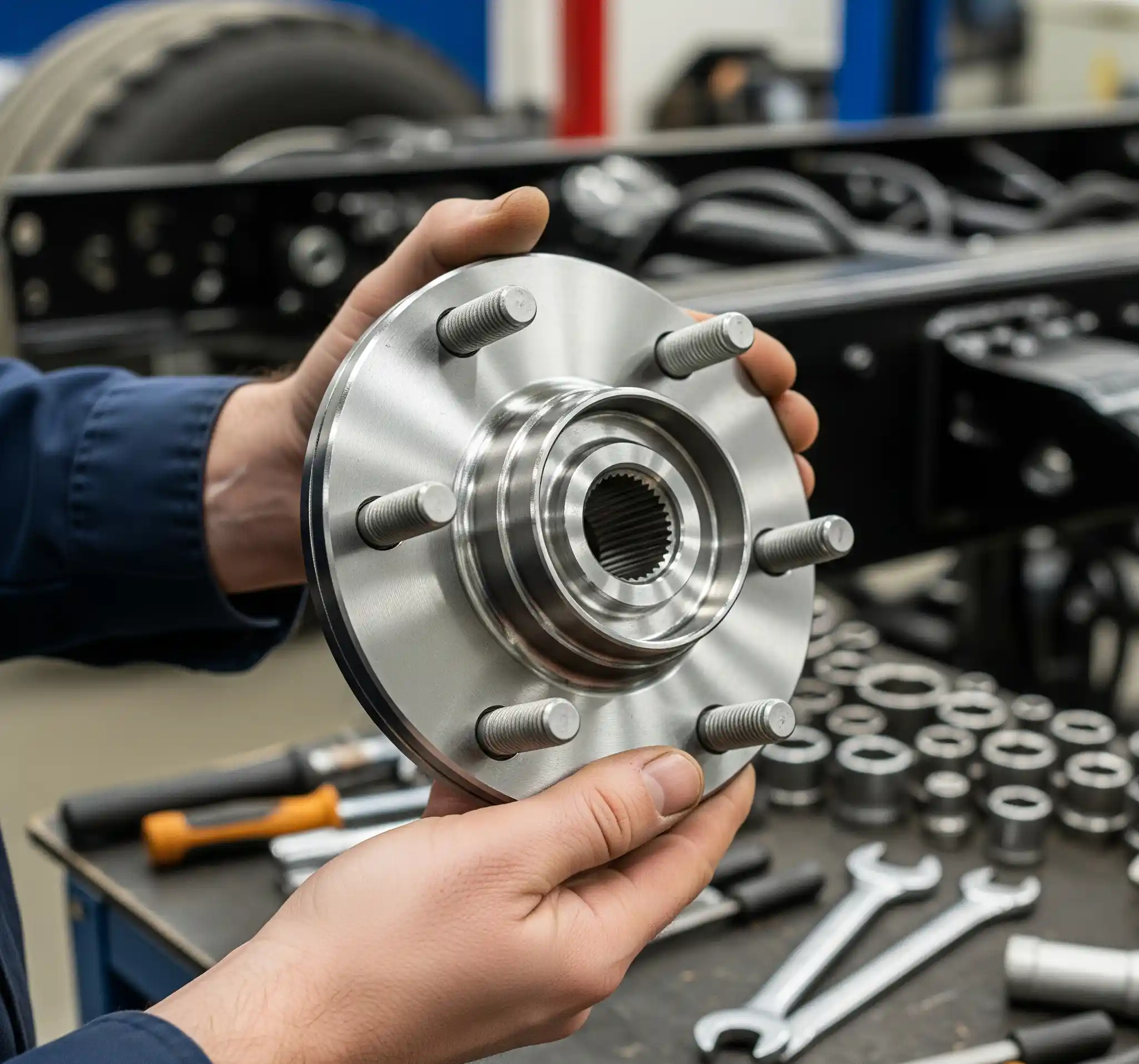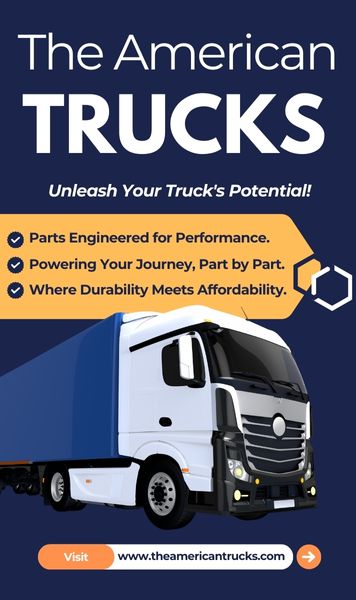
The Foundation of a Rolling Rig A Deep Dive into Wheel End Components and the Brake Hub
When a fully loaded American truck is thundering down the highway, it’s a testament to incredible engineering. We often think of the powerful engine or the robust transmission, but all that power and weight ultimately meet the road through one of the most critical and hardest-working systems on the entire vehicle: the wheel end. This compact assembly of steel and iron is the final link in the powertrain and the absolute foundation of your rig’s safety and reliability.
While it’s a system of many parts, its heart is a single, immensely strong component: the brake hub. The hub is more than just a mounting point; it’s the central anchor that carries the load, secures the wheel, and supports the braking system. In this guide, we’ll break down the entire wheel end assembly piece by piece, with a special focus on the brake hub, to understand how it works, how it fails, and why investing in quality components is non-negotiable.
What is a Truck Wheel End?
Before we zoom in on the hub, let’s look at the big picture. A truck wheel end is the complete assembly that connects the stationary axle to the rotating wheel and tire. Its job is twofold: support tens of thousands of pounds of vertical load while allowing the wheel to spin with minimal friction for millions of miles.
This is achieved through a precise interplay of several core components:
- The Brake Hub
- Inner and Outer Wheel Bearings
- The Wheel Seal
- Spindle Nuts and Locking System
- The Hub Cap
Each part is a link in a chain, and the failure of one inevitably leads to the destruction of the others.
The Heart of the Assembly The Brake Hub
If the wheel end is a solar system, the brake hub is its sun—the massive, central body around which everything else revolves. Made from high-strength ductile or grey cast iron, it must be strong enough to withstand immense forces and durable enough to dissipate the intense heat generated during braking.
Let’s dissect the anatomy of a typical brake hub to understand its critical functions:
- Hub Body: This is the main, heavy-duty structure. Its primary role is to house the bearing cups and provide a solid, stable foundation for the entire assembly.
- Wheel Studs: These are the threaded bolts pressed into the hub flange that the wheel is mounted onto. They do more than just hold the wheel on; they are responsible for transferring all the acceleration and braking torque from the hub to the wheel.
- Bearing Cups (Races): Inside the hub’s bore are two precision-machined, hardened steel rings. These are the outer races where the tapered inner and outer wheel bearings sit. The quality and precision of these surfaces are paramount. Any imperfection will lead to premature bearing failure.
- Brake Drum Pilot: This is the raised, circular shoulder on the outboard side of the hub. Its diameter is precisely machined to match the center hole of the brake drum. This ensures the drum is perfectly centered on the hub, preventing dangerous vibrations and ensuring even brake shoe contact.
- ABS Tone Ring: On modern trucks, the hub is equipped with a notched or toothed ring (the ABS tone or exciter ring). An ABS sensor reads the passing teeth to determine wheel speed, feeding this critical data to the ABS, traction control, and stability control systems. A damaged or dirty tone ring can cause major faults in these safety systems.
Signs of a Failing Brake Hub What to Look For
A brake hub is designed to last for a very long time, but it is not invincible. Potholes, curb strikes, overloading, and improper maintenance can lead to failure. Ignoring the warning signs can have catastrophic consequences. Here’s what to look for:
- Visible Cracks: This is the most dangerous sign of failure. Cracks often form under stress between the stud holes or radiate outwards from the center bore. A cracked hub has lost its structural integrity and must be replaced immediately.
- Worn or “Ovaled” Stud Holes: If lug nuts are run loose for an extended period, the movement of the wheel can wear the stud holes into an oval shape. When this happens, the wheel can never be properly secured again, leading to chronic vibration, broken studs, and eventually, a wheel-off event.
- Damaged Bearing Races: A catastrophic bearing failure can destroy the bearing cup inside the hub, scoring and galling the precision surface. While some hubs can have new cups pressed in, severe damage to the hub bore itself renders the entire brake hub useless.
- Worn Drum Pilot: Corrosion or damage to the pilot surface can prevent the brake drum from sitting perfectly flat and centered. This will cause an imbalance that leads to severe vibration and pulsating, ineffective brakes.
The Supporting Cast How Other Components Interact with the Hub
The brake hub cannot function in isolation. Its survival depends entirely on the health of its supporting components.
- Wheel Bearings: These tapered roller bearings fit into the hub’s races and ride on the axle spindle, carrying the entire load. They must be properly lubricated and adjusted to work correctly.
- Wheel Seal: This is the guardian of the hub’s interior. Located at the inboard side, this seal keeps the vital lubricating oil or grease in and protects the bearings from destructive contaminants like water and dirt. A leaking seal is the number one cause of bearing and hub failure.
- Spindle Nuts: This system of nuts and locks holds the entire hub assembly onto the axle spindle. More importantly, it is used to set the bearing “end play,” or the precise amount of clearance that allows the bearings to spin freely without being too loose or too tight. Improper adjustment is a leading cause of premature failure.
- Hub Cap: The final piece of the puzzle, the hub cap seals the outboard side of the hub. On oil-bath systems, it includes a clear window that allows for quick and easy inspection of the lubricant level and condition—a critical daily check for any driver.
Best Practices for Longevity and Safety
Ensuring a long and safe life for your brake hubs and wheel end components comes down to procedure and diligence.
- Cleanliness is Key: During any service, the hub and its components must be kept meticulously clean. A single grain of sand can destroy a new bearing.
- Proper Installation: Never use a hammer to install bearing cups. Always use a proper press or driver to ensure they go in straight and are fully seated without damaging the hub.
- Adhere to Torque Specs: Wheel studs must be tightened in a star pattern to the manufacturer’s recommended torque specification. Over-tightening can stretch and weaken the studs, while under-tightening will lead to a loose wheel and damaged hubs.
- Master the Adjustment: Setting wheel bearing end play is a skill that requires precision. Using a dial indicator to achieve the industry-standard .001″ to .005″ of end play is the only way to guarantee maximum bearing and hub life.
In conclusion, the brake hub is the unsung hero of your truck’s chassis. It is the bedrock upon which your safety and the vehicle’s reliability are built. By understanding its critical role and the importance of the components that support it, you can make informed maintenance decisions. Investing in high-quality hubs, bearings, and seals isn’t just an expense—it’s an investment in the integrity of your rig and peace of mind on the open road
You can visit our website for more details.




